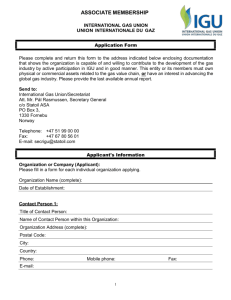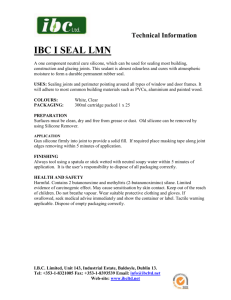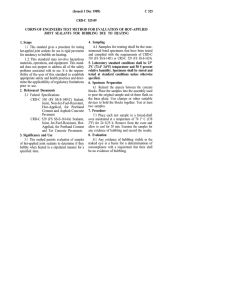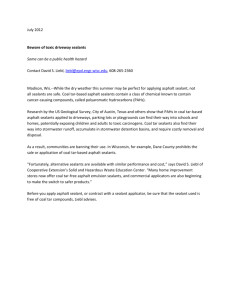Silicone Sealed Insulating Glass Units
advertisement
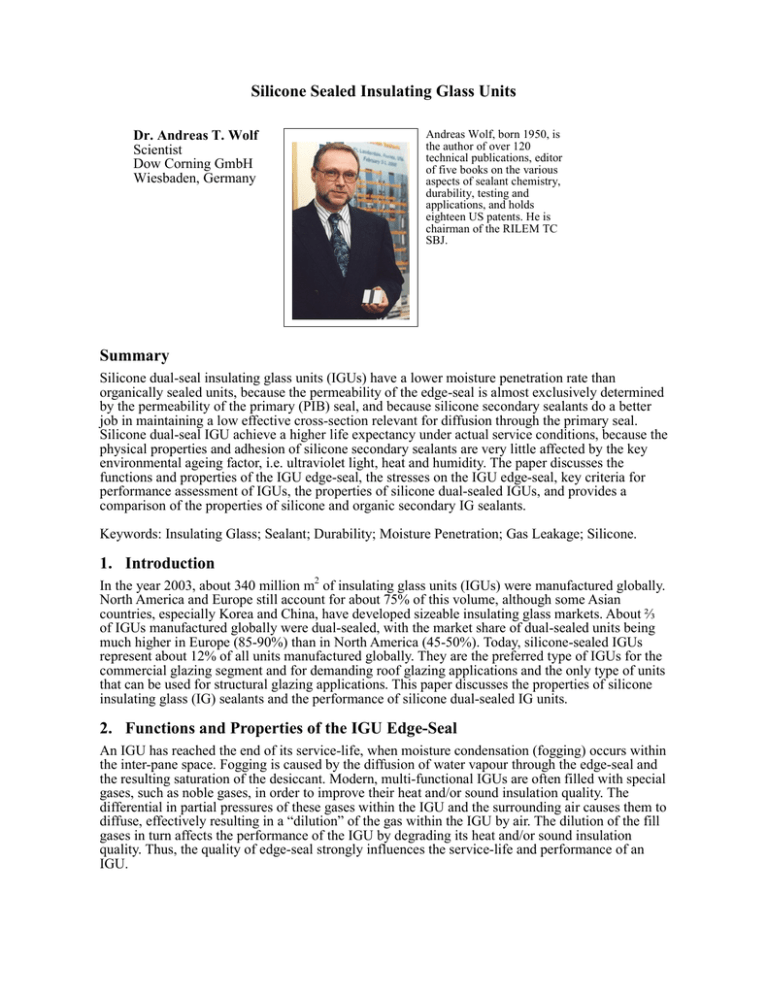
Silicone Sealed Insulating Glass Units Dr. Andreas T. Wolf Scientist Dow Corning GmbH Wiesbaden, Germany Andreas Wolf, born 1950, is the author of over 120 technical publications, editor of five books on the various aspects of sealant chemistry, durability, testing and applications, and holds eighteen US patents. He is chairman of the RILEM TC SBJ. Summary Silicone dual-seal insulating glass units (IGUs) have a lower moisture penetration rate than organically sealed units, because the permeability of the edge-seal is almost exclusively determined by the permeability of the primary (PIB) seal, and because silicone secondary sealants do a better job in maintaining a low effective cross-section relevant for diffusion through the primary seal. Silicone dual-seal IGU achieve a higher life expectancy under actual service conditions, because the physical properties and adhesion of silicone secondary sealants are very little affected by the key environmental ageing factor, i.e. ultraviolet light, heat and humidity. The paper discusses the functions and properties of the IGU edge-seal, the stresses on the IGU edge-seal, key criteria for performance assessment of IGUs, the properties of silicone dual-sealed IGUs, and provides a comparison of the properties of silicone and organic secondary IG sealants. Keywords: Insulating Glass; Sealant; Durability; Moisture Penetration; Gas Leakage; Silicone. 1. Introduction In the year 2003, about 340 million m2 of insulating glass units (IGUs) were manufactured globally. North America and Europe still account for about 75% of this volume, although some Asian countries, especially Korea and China, have developed sizeable insulating glass markets. About ⅔ of IGUs manufactured globally were dual-sealed, with the market share of dual-sealed units being much higher in Europe (85-90%) than in North America (45-50%). Today, silicone-sealed IGUs represent about 12% of all units manufactured globally. They are the preferred type of IGUs for the commercial glazing segment and for demanding roof glazing applications and the only type of units that can be used for structural glazing applications. This paper discusses the properties of silicone insulating glass (IG) sealants and the performance of silicone dual-sealed IG units. 2. Functions and Properties of the IGU Edge-Seal An IGU has reached the end of its service-life, when moisture condensation (fogging) occurs within the inter-pane space. Fogging is caused by the diffusion of water vapour through the edge-seal and the resulting saturation of the desiccant. Modern, multi-functional IGUs are often filled with special gases, such as noble gases, in order to improve their heat and/or sound insulation quality. The differential in partial pressures of these gases within the IGU and the surrounding air causes them to diffuse, effectively resulting in a “dilution” of the gas within the IGU by air. The dilution of the fill gases in turn affects the performance of the IGU by degrading its heat and/or sound insulation quality. Thus, the quality of edge-seal strongly influences the service-life and performance of an IGU. The key function of an insulating glass unit (IGU) edge-seal system is to provide a gas- and moisturebarrier and to structurally bond two or more panes of glass together. This can be achieved best with a dual edge-seal system, where the primary, polyisobutylene-based seal provides the barrier function, and the elastomeric secondary seal ensures the structural integrity of Fig. 1 Dual-Sealed Insulating Glass Unit the IGU under all relevant loads, such as occur during manufacture, transportation, installation, and service (see Figure 1). The regular service life and performance of an IGU are affected by the diffusion of moisture and gases through the effective cross-section of the primary seal. The majority of premature failures of IGUs, i.e. field failures within a few years of installation, are caused by loss of adhesion of the secondary seal [1]. 3. Stresses on the Edge-Seal of Insulating Glass Units IGUs are exposed to a variety of environmental factors, such as temperature and atmospheric pressure fluctuations, wind loads, working loads, sunlight, water and water vapour that negatively affect their life expectancy [2]. The stresses caused by the various environmental factors are not simply cumulative in their effect. Instead, their interaction results in a disproportionately higher stress on the edge-seal, a phenomenon known as synergism. Various studies [1,3-5] ascertained that the simultaneous action of water, elevated temperatures and sunlight constitutes the greatest stress on the edge-seal of an IGU. This degradative effect is most pronounced at the sealant/glass interface, often resulting in partial or complete adhesive failure of organic sealants, due to the channelling of UV radiation to the interface by total reflection within the glass panes. During service, the edge-seal of the glazed IGU is exposed to a microclimate within the window frame or curtain-wall construction that strongly deviates from the ambient climate. Two major studies have been conducted in an effort to monitor this microclimate in terms edge-seal temperature, moisture and presence of liquid water over the period of several years [1,6]. While in Central Europe edge-seal temperatures of clear glass IGUs seldom exceed 40°C, for tinted or coated glass units or in warm climates service temperatures may well reach 80°C and above for prolonged time-periods [7]. Therefore, an IGU edge-seal must have the following properties: • Durability, i.e. resistance against environmental factors (both in terms of physical properties and adhesion); • Structural strength that constrains movement in the edge-seal to minimize changes in the effective diffusion cross-section of the primary seal; • Low moisture- and gas-permeability under service conditions. 4. Performance of Silicone-Sealed Insulating Glass Units IG manufacturers generally use three methods to assess the performance of sealed IGUs: • • • Accelerated endurance testing (specific to IG manufacturer); Standardized test methods (DIN 1286 [8,9], EN 1279 [10,11], BS 5713 [12], CEKAL [13], ASTM E2190-02 and ASTM E774-97 [14,15]) ; Actual in-field performance. Before commercialising an IGU with a new edge-sealant, an IG manufacturer will subject units to accelerated endurance tests. These endurance test methods are typically specific to an IG manufacturer – each manufacturer has their own in-house test method – and are also often much more stringent than the official, government-imposed qualification tests. Once the IGU design passed the internal testing, the IG manufacturer submits it to an outside test institute for qualification (certification) testing. With the certification completed, the IG manufacturer is allowed to commercialise the new IGU design. After production start-up, the IG manufacturer will carefully monitor the units manufactured using suitable quality assurance procedures. The IG manufacturer will also record actual field-failure rates, in order to identify any longer-term problems with the installed units. Silicone-sealed IGUs excel in all performance aspects mentioned above. Consider the following comparison between silicone- and organic-sealed IGUs [2]: Identical, dual-sealed IGU test units (with identical components, i.e. glass, spacer, desiccant, primary sealant, and identical design) were prepared with six different secondary sealants – two sealant products for each sealant type, i.e. two polysulfides (PS1, PS2), two polyurethanes (PU1, PU2), and two silicones (Si1, Si2). One set of these units was then subjected to standardized testing (DIN 1286, part 1), which involved a changing climate test (cold and hot/humid climate) as well as UV exposure. Another set of these units was subjected to a manufacturer’s accelerated endurance test, which consisted of exposing the units to three months constant hot/humid climate of 55°C and 100% relative humidity. After completion of each test, the IGUs were destroyed, the desiccant was collected from the spacers, and the water content of the desiccant was determined. By subtracting the desiccant’s initial water content (prior to the test) from the final water content (after the test), the amount of water diffusing into the IGU during the test can be easily determined. Figure 2 shows the amount of water penetrating into the units during the accelerated endurance and standardized (DIN 1286, part 1) testing. The study clearly showed that the water penetration into the units was the lowest for the silicone-sealed IGUs! The difference in the behaviour of the secondary IG sealants can be observed already after the DIN 1286-1 testing, but is even more striking, when the units are exposed to the worst conceivable climate, i.e. storage at constant high temperature and high humidity. Under these conditions, the water penetration into the polysulfide-sealed IGU is almost twice as high as that of Fig. 2 Water Penetration into IGU During Accelerated Testing the silicone-sealed unit. Since the water penetration through the edge-seal is inversely proportional to the lifeexpectancy of an IGU – the more water vapour diffuses into the IGU, the shorter is its lifeexpectancy – it can be predicted, based on the above testing, that dual-seal IGUs manufactured with silicone sealants have a far higher life-expectancy than those sealed with polyurethane or polysulfide sealants. Indeed, this is what is actually observed by IG manufacturers in terms of field performance: silicone-sealed IGU have a significantly lower field failure rate than organically sealed units. 5. Properties of Silicone Dual-Sealed Insulating Glass Units As has been discussed before, actual IGU are exposed to a microclimate that strongly deviates from the ambient climate and is typically characterized by high temperatures and high humidity and, depending on the glazing (installation) situation, also high ultraviolet light levels. So, why do silicone-sealed IGUs perform that well in such an environment? It is for the following reasons: • Silicone dual-seal IGU have a lower moisture penetration rate under actual service conditions, because o in dual-seal IGUs, the permeability of the edge-seal is almost exclusively determined by the permeability of the primary (PIB) seal, and o silicone secondary sealants do a better job in maintaining a low effective crosssection for diffusion through the primary seal (as will be discussed, this is a result of their higher Young’s modulus and higher elastic recovery at elevated temperatures as well as their tendency to swell very little under the influence of high moisture or water) • Silicone dual-seal IGU achieve a higher life expectancy under actual service conditions, because o physical properties and adhesion of silicone secondary sealants are very little affected by the key environmental ageing factor, i.e. ultraviolet light, heat and humidity. 5.1 Moisture-Permeability of Dual-Seal Insulating Glass Units Since the majority of IGUs are dual-sealed, the diffusion resistance of a double layer system needs to be considered. The diffusion resistance of a plane-sheet laminate is the sum of the individual resistances of the various layers [16]: d = P n di ∑P i =1 (1) i When considering moisture diffusion, the water vapour permeability of the polyisobutylene (PIB) primary seal is far lower than that of the secondary seal, irrespective of whether the secondary seal is made of a silicone, polysulfide or polyurethane sealant. Therefore, the water vapour permeability of the dual edge-seal is determined almost exclusively by the permeability of the PIB primary seal: P1 << P2 ⇒ d d1 ≅ P P1 Fig. 3 Moisture Permeability of Secondary Seals and DualSeal Systems (Notation: 1p, 2p: one- and two-part, n: neutral cure, a: acetoxy cure, o: octoate cure) (2) Experimental studies into dual edge-seal systems [17] confirm this approximation. Figure 3 shows the moisture permeability of nine different commercial silicone and polysulfide secondary seals compared with that of the corresponding dualseals. As can be seen, the moisture permeability of silicone sealants depends on their formulation. While in general the polysulfide sealants tested have lower moisture permeabilities (at room temperature) than silicone sealants, these differences almost disappear, when the dual seal configuration is considered. It is important to note that, for experimental reasons, the moisture permeabilities were measured on a membrane thickness of 3 mm for the secondary seal and 1 mm for the primary seal. In an actual IGU, the typical thickness of the secondary seal would be about 4 mm and that of the primary seal about 4-6 mm. With such an increased thickness of the PIB primary seal, there is essentially no difference in the moisture permeability of silicone or polysulfide dual seals, as can be calculated with equation (1). 5.2 Maintaining the Effective Diffusion Cross-Section of the Primary Seal Obviously, the amount of moisture diffusing through the primary seal shows a linear dependency on the width and an inverse dependency on the depth of the primary seal (the wider and the thinner the primary seal, the higher the moisture diffusion). Therefore, maintaining the effective cross-section of the primary seal (as established after manufacture of the IGU) is very important for the longevity of the IGU. Fluctuations in atmospheric pressure as well as heat gain from solar radiation causes pressure differentials between the gas enclosed in the inter-pane space and the outside atmosphere; these pressure differentials in turn then cause deflections in the IGU panes (see Figure 4). The effect that the inwards and outwards bulging of the glass panes exerts on the edge seal varies with the dimensions of the IGU. The induced stress is highest for small IGUs or units with high aspect ratio (one long side and one short side) as well as units with wide inter-pane space. Fig. 4 Bulging of Glass Panes in an IGU Caused by The degree to which the primary seal Positive Pressure Differential expands when there is a positive pressure differential (higher pressure in the IGU than outside atmosphere) depends on the tensile stress (Young’s modulus) with which the secondary seal resists this applied force. The tensile stress of the secondary seal itself depends on the temperature. In practice, high temperatures are responsible for most positive pressure differentials. As has been discussed before, the edge-seal in IGUs can easily reach temperatures of 60-80°C during summer. Therefore, the tensile stress behaviour of secondary sealants at these elevated temperatures must be examined. 5.2.1 Effect of Temperature on Young’s Modulus of Secondary IG Sealants Figure 5 shows the temperaturedependency of the Young’s moduli of various commercial secondary IG sealants based on silicone, polyurethane and polysulfide. As can be seen, both silicone sealants show behaviour typical for ideal elastomers; their Young’s moduli increase slightly with temperature. On the other hand, the moduli of the two organic sealants show a strong dependency on temperature: they harden at low temperatures and soften at elevated temperatures. This behaviour is typical of Fig. 5 Young’s Moduli of Secondary IG Sealants as a materials with at least a partial Function of Temperature thermoplastic character. For instance, the Young’s modulus of the polyurethane sealant at 70°C is only about ⅓ of the value at –20°C. Because of their partial thermoplastic character, organic secondary IG sealants are less capable of resisting the expansion of the primary seal at elevated temperatures, thus more moisture diffuses into organically sealed IGU during periods of elevated temperature and humidity. 5.2.2 Effect of Temperature on Elastic Recovery of Secondary IG Sealants The amount of moisture diffusing through the primary seal obviously is also dependent on the time duration during which the primary seal expands (the longer the seal expands, the more moisture diffuses into the IGU). The primary seal will certainly expand to a certain degree (depending on the Young’s modulus of the secondary seal) during the duration of positive pressure differential. However, once the positive pressure differential ceases to exist, the time period, required by the secondary seal to return the primary seal to its original shape, varies, depending on the elastic Fig. 6 Effect of Elastic Recovery on Returning the Primary recovery of the secondary seal Seal to its Original Shape (see Figure 6). As with the Young’s modulus, the elastic recovery of a secondary IG sealant depends on the temperature. Figure 7 shows the temperature-dependency of the elastic recovery of various commercial secondary IG sealants based on silicone, polyurethane and polysulfide. As can be seen, the elastic recovery of all sealants decreases with temperature. However, while the silicone sealant shows the highest elastic recovery and only a very moderate reduction with temperature, the elastic recovery of the organic sealants tested decreases dramatically with temperature. As in the case of the Young’s modulus, the thermoplastic character of the organic sealants influences the elastic recovery behaviour: due to relaxation mechanisms (cold flow), their tensile stress decreases during maintained extension. As a result, when the applied force is eliminated, they are no longer capable of quickly returning the primary seal to its Fig. 7 Elastic Recovery of Secondary IG Sealants as a original size. If the secondary seal does not recover completely, the Function of Temperature primary seal remains permanently deformed. Consequently, a higher area is available for the diffusion of moisture for a certain period of time, until a negative pressure differential arises, which compresses the primary seal. 5.2.3 Water Pick-up and Swelling of Secondary IG Sealants At high moisture levels or under water immersion conditions, secondary IG sealant store water in their polymeric network, which increases their volume and degrades their mechanical properties (see Figure 8). For the most part, the extent of these negative effects is directly proportional to the amount of water pick-up. The volume increase of the secondary IG seal results in an opening of the primary seal, whereby the effective diffusion cross-section is enlarged. Due to the chemical nature of their polymeric backbone, polysulfide and polyurethane sealants store considerably higher quantities of water than do silicone sealants. Typical volume increases (swelling) after 60 days immersion in 60°C hot water are 6-12% for silicone sealants, 15-22% for polyurethane sealants and Fig. 8 Water Pick-up (Weight Gain %) of Secondary IG 38-55% for polysulfide sealants. The Sealants amount of water pick-up observed in silicone sealants depends on the type of adhesion promoter utilized in the formulation. 5.3 Durability of Secondary IG Sealants Contrary to organic sealants, both the adhesion and physical properties of silicone secondary IG sealants show excellent resistance against the combined effects of water, ultraviolet light and heat [18]. Figure 9 shows the changes in 25% secant moduli and tensile strengths of two silicone IG sealants during 20,000 hours of QUV weathering [19,20]. Specially formulated silicones are the only secondary IG sealant materials meeting or exceeding the requirements of EOTA ETAG 002 [21] and pr-EN 13022 [22] standards for IGU used in structural glazing. In these standards, the sealant is tested (both in tensile and in shear) after the following exposures: • Hot water with and without simulated solar radiation (ultraviolet light) • Humidity and salt spray environment • • Fig. 9 Changes in 25% Secant Moduli and Tensile Strengths of Silicone Secondary IG Sealants During QUV Weathering Humidity and SO2 gas environment Immersion in aqueous façade cleaning agents After these exposures, the sealant has to meet stringent requirements in terms of adhesion and mechanical strength. 6. Comparison of Silicone and Organic Secondary IG Sealants Table 1 provides an overview of the key material-specific performance characteristics of the cured elastomeric secondary IGU sealants (for a more detailed discussion see [2]). Table 1 Performance Characteristics of Cured Elastomeric Secondary IGU Sealants Material property Polysulfide (PS) Polyurethane (PU) Silicone (alkoxy) (Si) Resistance of glass adhesion to sunlight Resistance of adhesion to water (long-term exposure) Elastic recovery at 23°C at 60°C Change in Young’s modulus with temperature Water-swelling Water-vapour permeability (3 mm sheets) (g/(m2d) at 20°C at 60°C Argon permeability (0.6 mm sheets) (10-10 cm2/(s cmHg)) Water pick-up (weight %) of dual-sealed IGU Gas loss (% per year) of dual-sealed IGU Good Good to moderate Moderate Moderate Excellent Excellent to moderate Moderate Poor Good Moderate Excellent Excellent Very high Very high Moderate High Low Low 7-9 40-60 3-6 20-30 7-16 40-100 1.5-1.8 0.5-1.2 8-30 0.4-0.7 250-400 0.4-0.6 0.4-0.9 0.6-0.9 0.4-0.9 Clearly, the key performance advantage of polysulfide sealants is their low gas permeability, which allows them to tolerate poor workmanship, at least up to a certain degree (voids in the primary seal still lead to accelerated gas leakage, however, the gas loss is slow enough not to be visually noticed). The limited resistance of glass adhesion to sunlight prohibits the use of polysulfide and polyurethane sealants in structural glazing or roof glazing applications. Polyurethanes generally show better physical properties and lower water-vapour permeability than polysulfide sealants; their main selling feature, however, is their lower price. Silicone sealants, on the other hand, excel in the resistance of their glass adhesion to sunlight, making them the material of choice for structural and commercial glazing as well as demanding roof glazing applications. With over 20 years of experience with silicone sealants globally, the excellent performance and service-life of silicone dual-sealed IGUs have been demonstrated. One drawback of silicone sealants is their high gas permeability. However, recent experience has demonstrated that argon-filled, silicone dual-sealed IGU can be manufactured, which reliably pass DIN 1286-2 and EN 1279-3 requirements. Bent spacer-frame corners, gas-filling techniques integrated into the IGU assembling process (rather than filling via holes drilled into the spacer), improved, semi-automatic PIB application equipment and in-line (heated) PIB primary seal presses have all substantially contributed to the minimization of gas loss and helped with the improvement of quality and service-life of IGUs. Today, silicone dual-sealed IGUs can be produced that not only excel in their durability and longevity, but also reliably meet the stringent requirements for gas retention, and therefore provide optimum service-life and insulation value. This is because the properties of the polyisobutylene (PIB) primary seal and those of the silicone secondary seal complement each other very well. Table 2 shows the information provided in Table 1 in simplified form and considers the effect of combining the primary PIB seal with the various secondary seals. Table 2 Combined Performance Characteristics of Primary and Secondary IGU Sealants Material property PS PU Si PIB PIB/PS PIB/PU PIB/Si Resistance of glass adhesion to sunlight Resistance of adhesion to water (long-term exposure) Elastic recovery at 23°C at 60°C Change in Young’s modulus with temperature Water-swelling Water-vapour permeability at 20°C at 60°C Argon permeability (0.6 mm sheets) Overall performance of dual-sealed IGU IG for Structural Glazing (SSG) Water pick-up (weight %) of dual-sealed IGU Gas loss (% per year) of dual-sealed IGU ++ ++ + + ++++ +++ +++ -- ++ ++ + + ++++ +++ + ---- ++ + + - +++ +++ +++ +++ ---+ + ---- ++ + + - +++ +++ +++ +++ ++ + +++ +++ ++ ++ + + -- ++++ +++ ++++ ++++ +++ ++++ ++ -++ ++++ +++ +++ ++ -+++ ++++ +++ ++ +++ ++++ ++++ +++ ++ ++ As can be seen, silicone dual-sealed IGUs provide the best overall performance and can be used in demanding applications, such as • High-quality residential and commercial glazing • Applications involving high exposure to ultraviolet light, e.g. green houses, roof glazing, structural glazing • Applications involving specialty glass types (laminated glass, low-E glass, reflective solar protection glass, etc.) • Applications involving high levels of heat or humidity and/or cold climates • Transportation applications (trains, buses, etc.) Finally, it should be mentioned that there are also key differences in the characteristics of the wet (uncured) sealants. Silicones are far less sensitive to mixing problems (deviations from the specified mixing ratio) than polyurethane sealants. Furthermore, silicones are more ‘worker-friendly’ in terms of industrial hygiene considerations than both polyurethane and polysulfide sealants. 7. References [1] [2] [3] [4] [5] FELDMEIER, F., HEINRICH, R., HEPP, B., SCHMID, J. and STIELL, W., The Ageing Behaviour of Insulating Glass (in German), Institut für Fenstertechnik, Rosenheim, Germany, October 1984. WOLF, A.T., “Studies into the Life-Expectancy of Insulating Glass Units”, Building and Environment, Vol. 27, No. 3, 1992, pp. 305-319. VAN SANTEN, N., “The Ageing Behaviour of Insulating Glass - Laboratory Tests to Predict the Long-Term Performance of Insulating Glass Units” (in German), Glaswelt, Vol. 39, No. 3, 1986, pp. 12-20. LUDWIG, B. and WOLF, A.T., “Insulating Glass Sealants - Test and Evaluation Criteria’, Kautschuk und Gummi, Kunststoffe, Vol. 39, No. 10, 1986, pp. 922-928. LOWE, G.B., The Durability of Adhesion of Sealants to Glass, Ph.D. Thesis, De Montford University, Leicester, England, 1992. [6] GRAVIN, S.L. and WILSON, J., “Environmental Conditions in Windows Frames with Double-Glazed Units”, Construction and Building Materials, Vol. 12, 1998, pp. 289-302. [7] JACOB, L. and D’CRUZ. J., “Fundamental Concepts for the Design, Manufacture and Testing of IG Units for Warm Climate”, Glass Processing Days 13-16 June 1999, Ed J. Vitkala, Tamglass Ltd. Oy, Tampere, Finland, 1999. [8] DIN 1286 - Multiple Pane Insulating Glass, Part 1: Air Filled Insulating Glass Units, LongTerm Performance (in German), Germany Standard, DIN, Berlin, Germany, 1994. (DIN 1289 will be withdrawn following the publication of EN 1279). [9] DIN 1286 - Multiple Pane Insulating Glass, Part 2: Gas Filled Insulating Glass Units, LongTerm Performance (in German), Germany Standard, DIN, Berlin, Germany, 1989. [10] Pr-EN 1279 Draft: Glass in Building – Insulating Glass Units – Part 2: Long Term Test Method and Requirements for Moisture Penetration, CEN European Committee for Standardization, Brussels, Belgium, 2000. [11] Pr-EN 1279 Draft: Glass in Building – Insulating Glass Units – Part 3: Long Term Test Method and Requirements for Gas Leakage Rate and for Gas Concentration Tolerances, CEN European Committee for Standardization, Brussels, Belgium, 2000. [12] BS 5713: Hermetically Sealed Flat Double Glazing Units, Weather Cycling, Humidity Resistance, British Standardization Institute (BSI), London, United Kingdom (BS 5713 will be withdrawn following the publication of EN 1279. Although the UK does not currently require CE Marking, manufacturers will still need to meet the requirements of EN 1279 to fulfil the requirements of the European Construction Products Directive -CPD). [13] CEKAL: Insulating Glass – Requirements (in French), CEKAL Association, Paris, France, 1994. [14] ASTM E2190-02: Standard Specification for Insulating Glass Unit Performance and Evaluation, ASTM International, West Conshohocken, Pennsylvania, USA, 2002. [15] ASTM E774-97 Standard Specification for the Classification of the Durability of Sealed Insulating Glass Units, ASTM International, West Conshohocken, Pennsylvania, USA, 1997. [16] ASHWORTH, A.J., “Relation Between Gas Permselectivity and Permeability in a Bilayer Composite Membrane”, Journal of Membrane Science, Vol. 71, 1992, pp. 169-173. [17] MASSOTH, A. and WOLF, A.T., “Studies into the Water-Vapour Permeability of Single- and Dual-Phase Insulating Glass Sealant Systems”, Kautschuk und Gummi, Kunststoffe, Vol. 41, No. 9, 1988, pp. 882-887. [18] WOLF, A.T., Durability of Building Sealants, RILEM State-of-the-Art Report, RILEM Publications, Bagnaux, France, 2000. [19] ASTM G53-96 Standard Practice for Operating Light- and Water-Exposure Apparatus (Fluorescent UV-Condensation Type) for Exposure of Non-metallic Materials, ASTM International, West Conshohocken, Pennsylvania, USA, 1996. [20] WOLF, A.T., “Durability of Silicone Sealants”, Durability of Building Sealants, RILEM State-of-the-Art Report, A.T. Wolf, Ed., RILEM Publications, Bagnaux, France, 2000, pp. 253-273. [21] ETAG 002 – Guideline for European Technical Approval for Structural Sealant Glazing Systems (SSGS), Part 1 – Supported and Unsupported Systems, Edition November 1999, Amended June 2000, EOTA – European Organization for Technical Approvals, Brussels, Belgium, 2000. [22] Pr-EN 13022-2, Glass in Construction – Structural Sealant Glazing – Part 2: Product Standard for Ultraviolet Resistant Sealant and Structural Sealant, CEN European Committee for Standardization, Brussels, Belgium, 2002.
